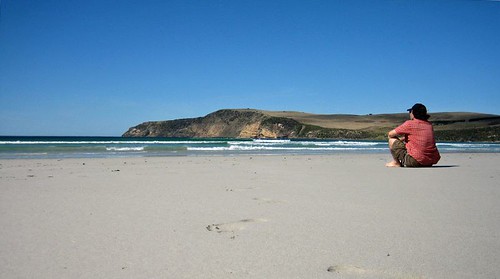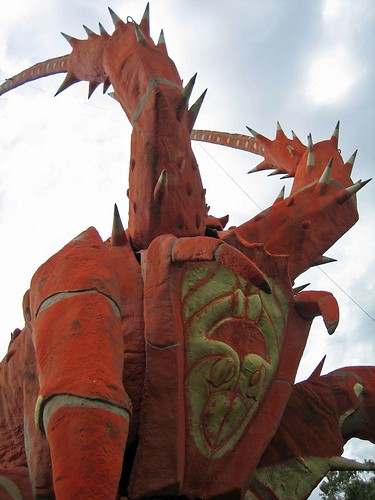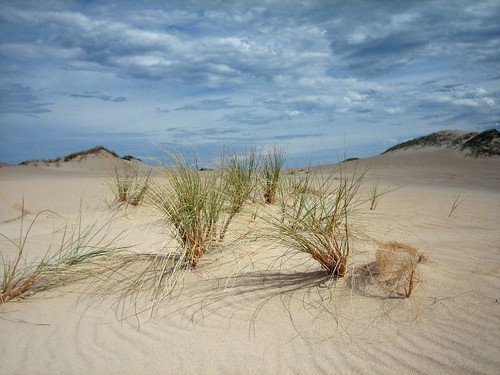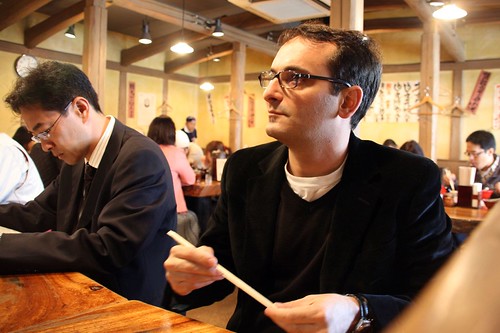Classic Coast: Days 3 and 4
(Note: This is part three of a series. Scroll down if you missed the first two posts.)
The first stop of day three was an hour outside of Port Fairy. A huge crescent of white sand beckoned at the beach at Bridgewater Bay. There was an option to take a boat ride out to Cape Bridgewater to see fur seals, but I chose to enjoy an hour of solitude on the deserted beach. We arrived early enough that the sun had not yet begun to bake the sand and fry our heads, and the hour I spent wandering the beach was one of the most pleasant of the whole trip. I mostly just walked slowly and gazed at the water, but did take some time for some self-portraits. The number of people who passed me during the hour could be counted on one hand. Double the count to include their dogs.

I returned on time to discover there was a delay for the folks on the boats trips, so we were given another hour at the beach. It was spent chatting with Bernie and Kate Barnes, a retired couple from England who I would spend a lot of time on the rest of the tour and in Adelaide. I’m tempted to say they were lovely, or charming, or some such thing, but they were too cool for cliché. We sat outside the beach’s café and did what travelers with time on their hands tend to do: traded stories, remarked on the scenery and discussed destinations on past and future trips. We also found a common interest in travelogues by Bill Bryson and laughed at his description of the giant kitschy statues dotted across Australia.
The last boat finally landed and we were on the road again and crossing into the state of South Australia.
The Australian government is serious about accidents on its highways, and frequent signs remind drivers to pull over and rest. “Drowsy Drivers Die” was one particularly alliterative example. Another reminder was the use of painted metal posts to mark the location of wrecks. Black posts meant a death; red signified an injury. Most of time a single post stood by the road, but some locations might offer four or five red posts and a black one at the end of the row. Once Lawrence clued me into the meaning of these markers, my eyes were peeled for them. (For kangaroos too, but I still haven’t seen a live one yet, only roadkill.)
With the Great Ocean Road behind us, there was more driving and fewer stops. We traveled away from the coast, but often I caught glimpses of the ocean in the distance.
The rest of day three included a trip to the Umpherston Sinkhole (more limestone) and a stop at the Blue Lake, a volcanic crater that is now a reservoir for the city of Mt. Gambier. The blue lake gets its color from, yes, you guessed it, the limestone. Calcite crystals dissolve in the water and turn it a shocking shade of blue. There was mention of phosphorus, but no stink lingered in the air.
The day ended with a short walk along the cliffs of Cape Buffon at Canunda National Park. After the Shipwreck Coast, this walk was less of the same. Still, getting out of the bus and stretching our legs left everyone prepared for a night out in the town of Robe. Our backpackers’ accommodation was a converted 1880’s mansion, complete with library, tv room, volleyball court and a resident puppy more than happy to play tug-o-war with the paying guests.
We had dinner at a local pub, where Lawrence got nipped in the ankle by a small snake while we hung out in a dark corner of the patio. It was enough for him to break a nervous sweat and leave to seek medical attention. With 10 of the 10 most venomous snakes in the world living in Australia, I don’t blame him for being cautious. It turned out to be nothing and he was ready to roll the next morning.
On day four, our last day on the Classic Coast, the heat was dampened by a cloud layer. Lawrence told us the first stop was a visit with his friend Larry, and he made a show of calling “Larry” before we arrived. Bernie, Kate and I knew what was up before the bus arrived at a giant lobster perched in front of a gift shop. Lobster fishing is a multimillion-dollar industry on this part of the South Australia coast, and Larry commemorates this with kitsch. Fifteen minutes with a giant lobster never killed anyone and we all had a good chuckle. Australia also has a giant pineapple, koala and other sculptures. The lobster is enough for me.

Larry stayed behind and we drove to Coorong National Park, a mass of wetlands that is extremely dry due to drought and the diversion of water to local farms. We stopped at 28 Mile Crossing for a walk over the sand dunes to another deserted beach. I could have spent the day there, but a tour is not a tour without a tight itinerary. As much as I enjoyed the trip and saw more than I ever would have seen on my own, it was disappointing to be told to move on after 45 minutes on this beautiful beach.

The Coorong is also home to the Ngarrindjiri Aboriginal people. The Ngarrindjri have bought their land back from the Australian government and are slowly populating the area with native plants and returning it, as much as is possible, to it’s natural state. We were given a tour of the area by a local guide and learned a smidgen about the area’s edible plants and the culture of the Ngarrindjiri nation. I wanted more, but was content with this first taste of Aboriginal life. There will be more as I travel around the country, especially into the center in March.
The afternoon was upon us as we crossed the Murray River on a ferry the size of a tea cracker, then up and down the Adelaide Hills (good wine country) for a stop at a corny Bavarian tourist town called Hahndorf. One overpriced Bavarian beer later, we piled back into the bus for the last time and made the short drive into Adelaide. Goodbyes, quick hugs and a round of see-ya-laters and the trip was over.
I had never taken a tour of this kind before and was anxious before it began. I’ve seen too many tour buses in my travels to be comfortable about being part of the masses. Guides carrying colored flags being followed by lemmings is not my style. We were stuck with a tight schedule, and covered a lot of ground between Melbourne and Adelaide – 750 miles in three and a half days – but the trip felt relaxed, the stretches in the bus were never too long and the group coalesced into a fun little unit. I’m happy I took a chance and hopped on the bus. Will I take another tour with 20 people? Probably not. But hey, who am I not to try something once?
Flickr Photo Set: Classic Coast (73 Photos)
The first stop of day three was an hour outside of Port Fairy. A huge crescent of white sand beckoned at the beach at Bridgewater Bay. There was an option to take a boat ride out to Cape Bridgewater to see fur seals, but I chose to enjoy an hour of solitude on the deserted beach. We arrived early enough that the sun had not yet begun to bake the sand and fry our heads, and the hour I spent wandering the beach was one of the most pleasant of the whole trip. I mostly just walked slowly and gazed at the water, but did take some time for some self-portraits. The number of people who passed me during the hour could be counted on one hand. Double the count to include their dogs.

I returned on time to discover there was a delay for the folks on the boats trips, so we were given another hour at the beach. It was spent chatting with Bernie and Kate Barnes, a retired couple from England who I would spend a lot of time on the rest of the tour and in Adelaide. I’m tempted to say they were lovely, or charming, or some such thing, but they were too cool for cliché. We sat outside the beach’s café and did what travelers with time on their hands tend to do: traded stories, remarked on the scenery and discussed destinations on past and future trips. We also found a common interest in travelogues by Bill Bryson and laughed at his description of the giant kitschy statues dotted across Australia.
The last boat finally landed and we were on the road again and crossing into the state of South Australia.
The Australian government is serious about accidents on its highways, and frequent signs remind drivers to pull over and rest. “Drowsy Drivers Die” was one particularly alliterative example. Another reminder was the use of painted metal posts to mark the location of wrecks. Black posts meant a death; red signified an injury. Most of time a single post stood by the road, but some locations might offer four or five red posts and a black one at the end of the row. Once Lawrence clued me into the meaning of these markers, my eyes were peeled for them. (For kangaroos too, but I still haven’t seen a live one yet, only roadkill.)
With the Great Ocean Road behind us, there was more driving and fewer stops. We traveled away from the coast, but often I caught glimpses of the ocean in the distance.
The rest of day three included a trip to the Umpherston Sinkhole (more limestone) and a stop at the Blue Lake, a volcanic crater that is now a reservoir for the city of Mt. Gambier. The blue lake gets its color from, yes, you guessed it, the limestone. Calcite crystals dissolve in the water and turn it a shocking shade of blue. There was mention of phosphorus, but no stink lingered in the air.
The day ended with a short walk along the cliffs of Cape Buffon at Canunda National Park. After the Shipwreck Coast, this walk was less of the same. Still, getting out of the bus and stretching our legs left everyone prepared for a night out in the town of Robe. Our backpackers’ accommodation was a converted 1880’s mansion, complete with library, tv room, volleyball court and a resident puppy more than happy to play tug-o-war with the paying guests.
We had dinner at a local pub, where Lawrence got nipped in the ankle by a small snake while we hung out in a dark corner of the patio. It was enough for him to break a nervous sweat and leave to seek medical attention. With 10 of the 10 most venomous snakes in the world living in Australia, I don’t blame him for being cautious. It turned out to be nothing and he was ready to roll the next morning.
On day four, our last day on the Classic Coast, the heat was dampened by a cloud layer. Lawrence told us the first stop was a visit with his friend Larry, and he made a show of calling “Larry” before we arrived. Bernie, Kate and I knew what was up before the bus arrived at a giant lobster perched in front of a gift shop. Lobster fishing is a multimillion-dollar industry on this part of the South Australia coast, and Larry commemorates this with kitsch. Fifteen minutes with a giant lobster never killed anyone and we all had a good chuckle. Australia also has a giant pineapple, koala and other sculptures. The lobster is enough for me.

Larry stayed behind and we drove to Coorong National Park, a mass of wetlands that is extremely dry due to drought and the diversion of water to local farms. We stopped at 28 Mile Crossing for a walk over the sand dunes to another deserted beach. I could have spent the day there, but a tour is not a tour without a tight itinerary. As much as I enjoyed the trip and saw more than I ever would have seen on my own, it was disappointing to be told to move on after 45 minutes on this beautiful beach.

The Coorong is also home to the Ngarrindjiri Aboriginal people. The Ngarrindjri have bought their land back from the Australian government and are slowly populating the area with native plants and returning it, as much as is possible, to it’s natural state. We were given a tour of the area by a local guide and learned a smidgen about the area’s edible plants and the culture of the Ngarrindjiri nation. I wanted more, but was content with this first taste of Aboriginal life. There will be more as I travel around the country, especially into the center in March.
The afternoon was upon us as we crossed the Murray River on a ferry the size of a tea cracker, then up and down the Adelaide Hills (good wine country) for a stop at a corny Bavarian tourist town called Hahndorf. One overpriced Bavarian beer later, we piled back into the bus for the last time and made the short drive into Adelaide. Goodbyes, quick hugs and a round of see-ya-laters and the trip was over.
I had never taken a tour of this kind before and was anxious before it began. I’ve seen too many tour buses in my travels to be comfortable about being part of the masses. Guides carrying colored flags being followed by lemmings is not my style. We were stuck with a tight schedule, and covered a lot of ground between Melbourne and Adelaide – 750 miles in three and a half days – but the trip felt relaxed, the stretches in the bus were never too long and the group coalesced into a fun little unit. I’m happy I took a chance and hopped on the bus. Will I take another tour with 20 people? Probably not. But hey, who am I not to try something once?
Flickr Photo Set: Classic Coast (73 Photos)



1 Comments:
I finally looked at a map of Australia to try to understand the distances, etc., and seriously - holy crap! Big place. And I found this cool comparison of the land mass of Australia to the US -they placed one country over the other in 2 different shades, so you could really see it - never realized they were about the same (even though I'm sure you told me).
Post a Comment
<< Home